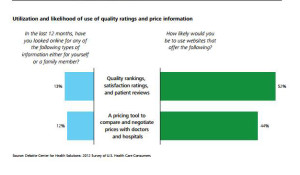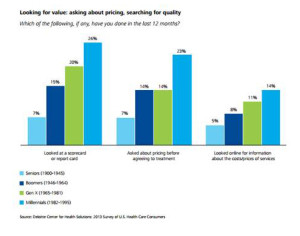 The consumer demand side for healthcare transparency is hungry for the light to shine on health care costs, quality and information that’s relevant and meaningful to the individual.
The consumer demand side for healthcare transparency is hungry for the light to shine on health care costs, quality and information that’s relevant and meaningful to the individual.
The supply side is fast-growing, with websites and portals, government-sponsored projects, commercial-driven start-ups, and numerous mobile apps. These tools endeavor to:
- Help people find and access services
- Schedule appointments
- Compare peer consumers’ reviews for those providers
- Calculate and prepare for out-of-pocket co-payments deriving from their health plan
- Negotiate prices with providers
- Pay for the services, and
- Reconcile the payment with a high-deductible health plan or health savings account.
On the demand side, consumers en masse haven’t flocked to the services already available to them, as Deloitte’s consumer research shown in the first two graphs point out. In the first instance, about 12-13% of consumers had sought health care quality and price information in the past year, with about one-half of people saying they’d be interested in doing so in the future. In the second graphic, younger people were more likely to seek price and quality information, but no age cohort approaches a majority…yet.
On the supply side, things will get increasingly crowded and may confuse consumers with their variability and lack of standardization across definitions and methodologies. Notwithstanding that, there are some great examples of transparency and online healthcare marketplace services that have evolved over the past few years and are still alive, kicking and building consumer brand-love:
ZocDoc, the online physician search and payment portal, began in metropolitan New York in 2007 and now covers over 2,000 cities – which it believes comprises 40% of the US population. One of the secrets in ZocDoc’s sauce is the inclusion of consumer/patient ratings, which allow patients shopping for health care services to not only identify providers in their community, but those who rise to the top of consumer experience and customer service.
Clear Health Costs (CHC), developed by New York City journalist Jeanne Pinder and a national network of reporters and information sharers, received a grant from the Knight Foundation in April 2014 to grow CHC’s health price transparency platform in California with the public radio stations KQED in San Francisco and KPCC/Southern California Public Radio. CHC has been working in a similar way in New York with WNYC public radio’s Brian Lehrer Show where women in New York City shared the prices they paid for mammograms.
Healthcare Blue Book provides consumers, through a zip code search, a “fair price” for a specific health service, and where available a list of providers in the consumers’ geography. The fair price discussion presents a good description of what a health care price means, and is based on the data collected for that consumers’ community. The organization is working with providers, payors and wellness providers Limeade.
Health Populi’s Hot Points: Some early-adopting consumers will be helped by these tools, but their fast-growth and lack of evidence-base for usage will prevent a huge influx and tipping point among consumers to use them. That’s why the consolidated approach of Aetna, Humana, and UnitedHealthcare discussed this week here in Part 3 holds promise for aggregating use among the 100 mm consumers touched by those three health plans.
In the venue of health care recommendations, U.S. consumers continue to be widely influenced by opinions and experiences of friends, family, and peers. That’s why the integration of consumer reviews on the transparency tool websites could make these sites more compelling and relevant to “me,” in my neighborhood, and among people sharing my medical condition. While TripAdvisor can serve up a recommendation for a hotel and then guide me to make a reservation for that experience, a tool that can serve up a match to a physician or MRI scan in my community that’s been hailed as a sensitive and competent provider by a fellow patient will rank higher than a list of providers and a price. All things being equal, I’d go for the recommendation from peers. All things being equal.
Healthcare transparency is integral to customer service in retail. As patients become health care consumers, this puts people into the retail environment as health care shoppers. How can someone shop without product information, price, quality, and consumer reviews?
We’ve entered the Season of Healthcare Transparency. We can expect a lot of chaos – in the form of many products and services, over- (and under-) valuation and expectations of digital health start-ups, and bumps in the road. But we’re on that road now, and that’s a good thing. We’ll all be developing a new kind of competency along the way — that is, consumer health literacy.





 Thank you FeedSpot for
Thank you FeedSpot for